Overview
- Brief Narrative
- 1 (eine) mark receipt issued in the Łódź ghetto in German occupied Poland beginning in May 1940 until the ghetto was liquidated in summer 1944. Nazi Germany invaded Poland on September 1, 1939, and occupied Łódź one week later. Łódź was renamed Litzmannstadt and, by February 1940, the Germans forcibly relocated the large Jewish population of 160,000 into a small, sealed ghetto. All residents had to do forced labor, many in ghetto factories. Residents were forbidden to have German currency, and the Jewish Council was ordered to create a system of Quittungen [receipts] for use only in the ghetto. The scrip, referred to as rumkis after the Elder of the Judenrat, Mordechai Rumkowski, was issued in 7 denominations: 50 pfenning, 1, 2, 5, 10, 20, 50, and 100 marks, as well as coins. It was a labor incentive and facilitated the confiscation of money and goods from internees. There was little to exchange it for in the ghetto. Living conditions were horrendous; the severe overcrowding and lack of food made disease and starvation common. In January 1942, mass deportations to Chelmno killing center began; half the residents were murdered by the end of the year. In summer 1944, Łódź, the last ghetto in Poland, was destroyed and the remaining Jews were sent to Chelmno and Auschwitz-Birkenau killing centers.
- Date
-
issue:
1940 May 15
- Geography
-
issue:
Litzmannstadt-Getto (Łódź, Poland);
Łódź (Poland)
- Credit Line
- United States Holocaust Memorial Museum Collection, Gift of Miles Lerman
- Markings
- face, serial number, red ink : Nº 959644
face, upper right, black ink : Quittung / über [Receipt for about]
face, center, bold font, black ink : Eine Mark [One Mark]
face, bottom, black ink : Der Aelteste der Juden / in Litzmannstadt / M. Rumkowski / Litzmannstadt , den 15 Mai 1940 [The Eldest of the Jews / M. Rumkowski / on May 15, 1940]
back, black ink : Quittung / über / Eine Mark [Receipt for about one mark]
back, bottom, black ink : WER DIESE QUITTUNG VERFÄLSCHT ODER NACH. / MACHT ODER GEFÄLSCHTE QUITTUNGEN IN / VERKEHR BRINGT WIRD STRENGSTENS BESTRAFT [ANYONE WHO FALSIFIES OR COPIES THIS RECEIPT, OR TRAFFICS IN COUNTERFEIT RECEIPTS, WILL BE STRICTLY PUNISHED] - Contributor
-
Subject:
Miles Lerman
- Biography
-
Shmuel Milek Lerman was born on January 20, 1920, in Tomaszow Lubelski, Poland, to Israel and Jochevet Lerman. His parents were among the most prosperous members of the Jewish community. Israel owned and leased a string of flour mills throughout eastern Poland. A profession his family had followed for many generations. He also owned wholesale liquor and gasoline businesses. Jochevet owned a wholesale import company that specialized in tea, coffee and spices. Shmuel had four older siblings: Shlomo, b. 1904, Esther b. 1906, Peshe b. 1908, and Yona b. 1910. It was a religious, traditional Hasidic family. His father had studied with the Rabbi of Belz, and they were financial supporters of the Belzer Hasidim. Shmuel joined the socialist Zionist Hashomer Hatzair youth. His brother Yoshe went to Palestine in 1934. Shmuel was in the Jewish sports clubs, Maccabi and Hapoel. His brother Yona left for His last two years of high school, 1936-1938, were spent at a secular, Hebrew junior college in Lvov. He planned to immigrate to Palestine and attend Hebrew University in Jerusalem. In 1938, his father died from a stroke. The family insisted Shmuel return to Tomaszow to help his mother. His older brother Shlomo took over his father's businesses, and Shmuel helped his mother with the import business.
On September 1, 1939, Germany invaded Poland. The family home was destroyed by a German bomb. Shmuel and his mother moved to Lvov (Lviv, Ukraine.) The Soviet Union invaded in mid-September and divided the country with Germany per the German Soviet Pact. Lvov was in the Soviet sector. They had no possessions but enough money to rent a small apartment. Hi brothers Shlomo and Peshe and their families soon joined them. Shmuel was assistant manager in the state office of supply. In 1940, Shlomo, Peshe, and their families were deported to Soviet Asia. His mother was to be deported as well, but Shmuel convinced an NKVD [Soviet Secret Police] officer at the railroad station to let her disembark.
In June 1941, Nazi Germany invaded the Soviet Union. There was a series of massacres : first the NKVD killed thousands pf political prisoners as they abandoned the city, then the local Ukrainians slaughtered thousands of Jews in the streets, and then German troops with mobile killings units which targeted Jews arrived. Shmuel was working for the railroad authority and had a certificate of employment from the Wehrmacht. Not trusting that the document would protect him from the roving bands of Ukrainian nationalists, who were grabbing Jewish men off the street and from their homes and shooting them, Shmuel hid for a few days in the basement of his apartment building. He then went back to work for the railroad, where he was now paid only a token amount. As of July 8, Shmuel and all Jews 14 years and older had to wear white armbands with a blue Star of David. Later that summer, amid the confiscation of Jewish property, synagogue burnings and cemetery desecration, the Germans established a Jewish council, labor bureau and police force. On November 8, they set up a ghetto. In December 1941, Shmuel was stopped after work by an SS man and a Ukrainian auxiliary, who tore up his work certificate and forced him onto a truck with 60-70 other Jewish men. He was taken to Viniki labor camp, and put to work building a highway between Lvov and Viniki. To obtain gravel for the roadwork the Jewish forced laborers had to break up the tombstones in the ancient Lvov Jewish cemetery. Shmuel sent a message to his mother through a friend of his girlfriend Lucia. In mid-March 1942, the first large scale action In Lvov ghetto deported 15,000 Jews to Belzec killing center. Shmuel's mother Jochevet was taken. Lucia, his girlfriend, evaded the round-up and fled to Viniki and told Shmuel. Lucia was soon captured and sent to Janowska concentration camp. One day in spring 1942, Shmuel and four other prisoners were instructed to move deeper into the quarry they were working in to find a harder type of stone. The five of them killed their two Ukrainian guards with their picks and shovels, took their weapons, and fled into the forest. After two months, Shmuel and his group had gathered around them 200-250 Jews which they organized into a partisan family camp. Shmuel and several other young men were in command. The Jewish partisans developed a loose alliance with local bands of Polish Home Army partisans, who sought their support against anti-Polish, Ukrainian resistance forces in the area. For 23 months, Shmuel lived as a partisan in the forests, surviving by trading with, or stealing from, local villagers and raiding German supply depots.
After the liberation, Shmuel returned to Tomaszow. But antisemitism was active and he was warned to leave before he was killed. He discovered that his mother had been murdered in Belzec. He went to Lublin, where he established a leather business with a fellow survivor, Leon Feldhandler from Izbica, who had been a leader in the Sobibor killing center uprising. Shortly after, Feldhandler was killed by a Polish man. Shmuel decided to move on. He settled in Łódź, where he opened a nightclub with a friend. He met Rozalia (Krysia) Laks one evening at his club. Rozaliemwas born in March 2016 in Starachowice, Poland, and, with her two sisters, survived slave labor and Auschwitz-Birkenau concentration camp. They were soon married in Łódź by the chief rabbi of the Polish Army. While in Łódź, Shmuel made contact with his brother Yona in Palestine and learned that Shlomo and Peshe had survived, but Esther and her family had not. Shmuel made use of his contacts in the Polish government to develop a business in which he supplied certain foodstuffs procured on the black market to the government in exchange for textiles to sell on the open market. Shmuel and Rozalia, with Rozalia’s sister Regina, decided to leave for Germany in order to get to Palestine. They fled to Berlin, and lived in Schlachtensee displaced persons camp. They decided to apply for visas for America. They sailed from Hamburg to New York aboard the SS Marine Perch in February 1947. Upon arrival, they Americanized their names to Miles and Chris Lerman. They lived in New York as well as New Jersey, operating a poultry farm and a large heating oil business. In 1980, Miles was appointed by President Jimmy Carter to the U.S. Holocaust Memorial Council, which became the governing body of the U.S. Holocaust Memorial Museum. He directed the International Relations Committee and served as national chairman of the Campaign to Remember, leading the initiative to raise the funds needed to build the Museum. He was reappointed to the Council by Presidents Reagan and Bush, and was chairman from 1993-2000. As a Council member through 2003, he negotiated agreements with foreign governments that brought archival materials and artifacts to the Museum. He was a founding member of the Council's Committee on Conscience, which was established in 1995 to focus attention on, and help stop, contemporary acts of genocide. Miles, 88, passed away in 2008. His wife, Chris, 90, passed away on May 19, 2016.
Physical Details
- Language
- German
- Classification
-
Exchange Media
- Category
-
Money
- Object Type
-
Scrip (aat)
- Genre/Form
- Money
- Physical Description
- Łódź ghetto scrip on rectangular white paper printed in green ink with black text. The face has a background latticework pattern. The denomination 1 is in the lower right corner in bold font. There is a 1 inch right margin, then a rectangle with a border of barbed wire interspersed with Stars of David. The inside has a background of interlocked Jewish stars with a large star in a circle in the upper left corner and a smaller one in the center of the right side border. Across the center is the denomination and other German text. The serial number in red ink replaces the upper right border. The back has a blank background with the denomination 1 in bold font in the lower left corner. There is a 1 inch left margin, then a rectangle with a border of barbed wire interspersed with Stars of David. The inside has 2 sets of 8 concentric rings with the numerical denomination in the center. A banner with the textual denomination connects the rings. The banner crosses over a 7-branched candelabrum in the center, with German text above and below. The scrip is worn and soiled, wrinkled, with deep creases, stains, uneven edges, with tape on the back.
- Dimensions
- overall: Height: 2.500 inches (6.35 cm) | Width: 4.625 inches (11.748 cm)
- Materials
- overall : paper, ink
Rights & Restrictions
- Conditions on Access
- No restrictions on access
- Conditions on Use
- No restrictions on use
Keywords & Subjects
Administrative Notes
- Legal Status
- Permanent Collection
- Provenance
- The scrip was donated to the United States Holocaust Memorial Museum in 1999 by Miles Lerman.
- Funding Note
- The cataloging of this artifact has been supported by a grant from the Conference on Jewish Material Claims Against Germany.
- Record last modified:
- 2023-05-31 13:04:37
- This page:
- https://collections.ushmm.org/search/catalog/irn521408
Download & Licensing
In-Person Research
- By Appointment
- Request 21 Days in Advance of Visit
- Plan a Research Visit
- Request to See This Object
Contact Us
Also in Miles Lerman collection
Collection of one (eine) Mark bills (scrip) issued in the Łódź ghetto, Poland; issued May 1, 1940.
Date: 1940 May 01
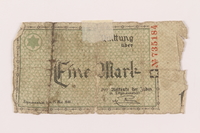
Łódź (Litzmannstadt) ghetto scrip, 1 mark note
Object
1 (eine) mark receipt issued in the Łódź ghetto in German occupied Poland beginning in May 1940 until the ghetto was liquidated in summer 1944. Nazi Germany invaded Poland on September 1, 1939, and occupied Łódź one week later. Łódź was renamed Litzmannstadt and, by February 1940, the Germans forcibly relocated the large Jewish population of 160,000 into a small, sealed ghetto. All residents had to do forced labor, many in ghetto factories. Residents were forbidden to have German currency, and the Jewish Council was ordered to create a system of Quittungen [receipts] for use only in the ghetto. The scrip, referred to as rumkis after the Elder of the Judenrat, Mordechai Rumkowski, was issued in 7 denominations: 50 pfenning, 1, 2, 5, 10, 20, 50, and 100 marks, as well as coins. It was a labor incentive and facilitated the confiscation of money and goods from internees. There was little to exchange it for in the ghetto. Living conditions were horrendous; the severe overcrowding and lack of food made disease and starvation common. In January 1942, mass deportations to Chelmno killing center began; half the residents were murdered by the end of the year. In summer 1944, Łódź, the last ghetto in Poland, was destroyed and the remaining Jews were sent to Chelmno and Auschwitz-Birkenau killing centers.
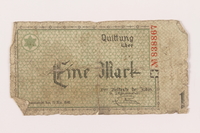
Łódź (Litzmannstadt) ghetto scrip, 1 mark note
Object
1 (eine) mark receipt issued in the Łódź ghetto in German occupied Poland beginning in May 1940 until the ghetto was liquidated in summer 1944. Nazi Germany invaded Poland on September 1, 1939, and occupied Łódź one week later. Łódź was renamed Litzmannstadt and, by February 1940, the Germans forcibly relocated the large Jewish population of 160,000 into a small, sealed ghetto. All residents had to do forced labor, many in ghetto factories. Residents were forbidden to have German currency, and the Jewish Council was ordered to create a system of Quittungen [receipts] for use only in the ghetto. The scrip, referred to as rumkis after the Elder of the Judenrat, Mordechai Rumkowski, was issued in 7 denominations: 50 pfenning, 1, 2, 5, 10, 20, 50, and 100 marks, as well as coins. It was a labor incentive and facilitated the confiscation of money and goods from internees. There was little to exchange it for in the ghetto. Living conditions were horrendous; the severe overcrowding and lack of food made disease and starvation common. In January 1942, mass deportations to Chelmno killing center began; half the residents were murdered by the end of the year. In summer 1944, Łódź, the last ghetto in Poland, was destroyed and the remaining Jews were sent to Chelmno and Auschwitz-Birkenau killing centers.
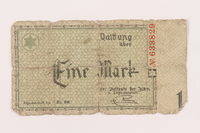
Łódź (Litzmannstadt) ghetto scrip, 1 mark note
Object
1 (eine) mark receipt issued in the Łódź ghetto in German occupied Poland beginning in May 1940 until the ghetto was liquidated in summer 1944. Nazi Germany invaded Poland on September 1, 1939, and occupied Łódź one week later. Łódź was renamed Litzmannstadt and, by February 1940, the Germans forcibly relocated the large Jewish population of 160,000 into a small, sealed ghetto. All residents had to do forced labor, many in ghetto factories. Residents were forbidden to have German currency, and the Jewish Council was ordered to create a system of Quittungen [receipts] for use only in the ghetto. The scrip, referred to as rumkis after the Elder of the Judenrat, Mordechai Rumkowski, was issued in 7 denominations: 50 pfenning, 1, 2, 5, 10, 20, 50, and 100 marks, as well as coins. It was a labor incentive and facilitated the confiscation of money and goods from internees. There was little to exchange it for in the ghetto. Living conditions were horrendous; the severe overcrowding and lack of food made disease and starvation common. In January 1942, mass deportations to Chelmno killing center began; half the residents were murdered by the end of the year. In summer 1944, Łódź, the last ghetto in Poland, was destroyed and the remaining Jews were sent to Chelmno and Auschwitz-Birkenau killing centers.
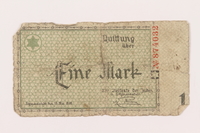
Łódź (Litzmannstadt) ghetto scrip, 1 mark note
Object
1 (eine) mark receipt issued in the Łódź ghetto in German occupied Poland beginning in May 1940 until the ghetto was liquidated in summer 1944. Nazi Germany invaded Poland on September 1, 1939, and occupied Łódź one week later. Łódź was renamed Litzmannstadt and, by February 1940, the Germans forcibly relocated the large Jewish population of 160,000 into a small, sealed ghetto. All residents had to do forced labor, many in ghetto factories. Residents were forbidden to have German currency, and the Jewish Council was ordered to create a system of Quittungen [receipts] for use only in the ghetto. The scrip, referred to as rumkis after the Elder of the Judenrat, Mordechai Rumkowski, was issued in 7 denominations: 50 pfenning, 1, 2, 5, 10, 20, 50, and 100 marks, as well as coins. It was a labor incentive and facilitated the confiscation of money and goods from internees. There was little to exchange it for in the ghetto. Living conditions were horrendous; the severe overcrowding and lack of food made disease and starvation common. In January 1942, mass deportations to Chelmno killing center began; half the residents were murdered by the end of the year. In summer 1944, Łódź, the last ghetto in Poland, was destroyed and the remaining Jews were sent to Chelmno and Auschwitz-Birkenau killing centers.
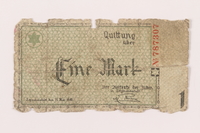
Łódź (Litzmannstadt) ghetto scrip, 1 mark note
Object
1 (eine) mark receipt issued in the Łódź ghetto in German occupied Poland beginning in May 1940 until the ghetto was liquidated in summer 1944. Nazi Germany invaded Poland on September 1, 1939, and occupied Łódź one week later. Łódź was renamed Litzmannstadt and, by February 1940, the Germans forcibly relocated the large Jewish population of 160,000 into a small, sealed ghetto. All residents had to do forced labor, many in ghetto factories. Residents were forbidden to have German currency, and the Jewish Council was ordered to create a system of Quittungen [receipts] for use only in the ghetto. The scrip, referred to as rumkis after the Elder of the Judenrat, Mordechai Rumkowski, was issued in 7 denominations: 50 pfenning, 1, 2, 5, 10, 20, 50, and 100 marks, as well as coins. It was a labor incentive and facilitated the confiscation of money and goods from internees. There was little to exchange it for in the ghetto. Living conditions were horrendous; the severe overcrowding and lack of food made disease and starvation common. In January 1942, mass deportations to Chelmno killing center began; half the residents were murdered by the end of the year. In summer 1944, Łódź, the last ghetto in Poland, was destroyed and the remaining Jews were sent to Chelmno and Auschwitz-Birkenau killing centers.
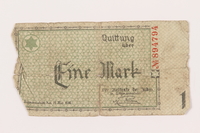
Łódź (Litzmannstadt) ghetto scrip, 1 mark note
Object
1 (eine) mark receipt issued in the Łódź ghetto in German occupied Poland beginning in May 1940 until the ghetto was liquidated in summer 1944. Nazi Germany invaded Poland on September 1, 1939, and occupied Łódź one week later. Łódź was renamed Litzmannstadt and, by February 1940, the Germans forcibly relocated the large Jewish population of 160,000 into a small, sealed ghetto. All residents had to do forced labor, many in ghetto factories. Residents were forbidden to have German currency, and the Jewish Council was ordered to create a system of Quittungen [receipts] for use only in the ghetto. The scrip, referred to as rumkis after the Elder of the Judenrat, Mordechai Rumkowski, was issued in 7 denominations: 50 pfenning, 1, 2, 5, 10, 20, 50, and 100 marks, as well as coins. It was a labor incentive and facilitated the confiscation of money and goods from internees. There was little to exchange it for in the ghetto. Living conditions were horrendous; the severe overcrowding and lack of food made disease and starvation common. In January 1942, mass deportations to Chelmno killing center began; half the residents were murdered by the end of the year. In summer 1944, Łódź, the last ghetto in Poland, was destroyed and the remaining Jews were sent to Chelmno and Auschwitz-Birkenau killing centers.
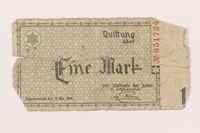
Łódź (Litzmannstadt) ghetto scrip, 1 mark note
Object
1 (eine) mark receipt issued in the Łódź ghetto in German occupied Poland beginning in May 1940 until the ghetto was liquidated in summer 1944. Nazi Germany invaded Poland on September 1, 1939, and occupied Łódź one week later. Łódź was renamed Litzmannstadt and, by February 1940, the Germans forcibly relocated the large Jewish population of 160,000 into a small, sealed ghetto. All residents had to do forced labor, many in ghetto factories. Residents were forbidden to have German currency, and the Jewish Council was ordered to create a system of Quittungen [receipts] for use only in the ghetto. The scrip, referred to as rumkis after the Elder of the Judenrat, Mordechai Rumkowski, was issued in 7 denominations: 50 pfenning, 1, 2, 5, 10, 20, 50, and 100 marks, as well as coins. It was a labor incentive and facilitated the confiscation of money and goods from internees. There was little to exchange it for in the ghetto. Living conditions were horrendous; the severe overcrowding and lack of food made disease and starvation common. In January 1942, mass deportations to Chelmno killing center began; half the residents were murdered by the end of the year. In summer 1944, Łódź, the last ghetto in Poland, was destroyed and the remaining Jews were sent to Chelmno and Auschwitz-Birkenau killing centers.
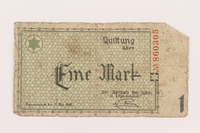
Łódź (Litzmannstadt) ghetto scrip, 1 mark note
Object
1 (eine) mark receipt issued in the Łódź ghetto in German occupied Poland beginning in May 1940 until the ghetto was liquidated in summer 1944. Nazi Germany invaded Poland on September 1, 1939, and occupied Łódź one week later. Łódź was renamed Litzmannstadt and, by February 1940, the Germans forcibly relocated the large Jewish population of 160,000 into a small, sealed ghetto. All residents had to do forced labor, many in ghetto factories. Residents were forbidden to have German currency, and the Jewish Council was ordered to create a system of Quittungen [receipts] for use only in the ghetto. The scrip, referred to as rumkis after the Elder of the Judenrat, Mordechai Rumkowski, was issued in 7 denominations: 50 pfenning, 1, 2, 5, 10, 20, 50, and 100 marks, as well as coins. It was a labor incentive and facilitated the confiscation of money and goods from internees. There was little to exchange it for in the ghetto. Living conditions were horrendous; the severe overcrowding and lack of food made disease and starvation common. In January 1942, mass deportations to Chelmno killing center began; half the residents were murdered by the end of the year. In summer 1944, Łódź, the last ghetto in Poland, was destroyed and the remaining Jews were sent to Chelmno and Auschwitz-Birkenau killing centers.
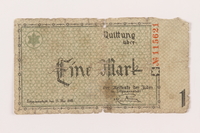
Łódź (Litzmannstadt) ghetto scrip, 1 mark note
Object
1 (eine) mark receipt issued in the Łódź ghetto in German occupied Poland beginning in May 1940 until the ghetto was liquidated in summer 1944. Nazi Germany invaded Poland on September 1, 1939, and occupied Łódź one week later. Łódź was renamed Litzmannstadt and, by February 1940, the Germans forcibly relocated the large Jewish population of 160,000 into a small, sealed ghetto. All residents had to do forced labor, many in ghetto factories. Residents were forbidden to have German currency, and the Jewish Council was ordered to create a system of Quittungen [receipts] for use only in the ghetto. The scrip, referred to as rumkis after the Elder of the Judenrat, Mordechai Rumkowski, was issued in 7 denominations: 50 pfenning, 1, 2, 5, 10, 20, 50, and 100 marks, as well as coins. It was a labor incentive and facilitated the confiscation of money and goods from internees. There was little to exchange it for in the ghetto. Living conditions were horrendous; the severe overcrowding and lack of food made disease and starvation common. In January 1942, mass deportations to Chelmno killing center began; half the residents were murdered by the end of the year. In summer 1944, Łódź, the last ghetto in Poland, was destroyed and the remaining Jews were sent to Chelmno and Auschwitz-Birkenau killing centers.
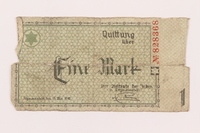
Łódź (Litzmannstadt) ghetto scrip, 1 mark note
Object
1 (eine) mark receipt issued in the Łódź ghetto in German occupied Poland beginning in May 1940 until the ghetto was liquidated in summer 1944. Nazi Germany invaded Poland on September 1, 1939, and occupied Łódź one week later. Łódź was renamed Litzmannstadt and, by February 1940, the Germans forcibly relocated the large Jewish population of 160,000 into a small, sealed ghetto. All residents had to do forced labor, many in ghetto factories. Residents were forbidden to have German currency, and the Jewish Council was ordered to create a system of Quittungen [receipts] for use only in the ghetto. The scrip, referred to as rumkis after the Elder of the Judenrat, Mordechai Rumkowski, was issued in 7 denominations: 50 pfenning, 1, 2, 5, 10, 20, 50, and 100 marks, as well as coins. It was a labor incentive and facilitated the confiscation of money and goods from internees. There was little to exchange it for in the ghetto. Living conditions were horrendous; the severe overcrowding and lack of food made disease and starvation common. In January 1942, mass deportations to Chelmno killing center began; half the residents were murdered by the end of the year. In summer 1944, Łódź, the last ghetto in Poland, was destroyed and the remaining Jews were sent to Chelmno and Auschwitz-Birkenau killing centers.
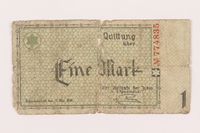
Łódź (Litzmannstadt) ghetto scrip, 1 mark note
Object
1 (eine) mark receipt issued in the Łódź ghetto in German occupied Poland beginning in May 1940 until the ghetto was liquidated in summer 1944. Nazi Germany invaded Poland on September 1, 1939, and occupied Łódź one week later. Łódź was renamed Litzmannstadt and, by February 1940, the Germans forcibly relocated the large Jewish population of 160,000 into a small, sealed ghetto. All residents had to do forced labor, many in ghetto factories. Residents were forbidden to have German currency, and the Jewish Council was ordered to create a system of Quittungen [receipts] for use only in the ghetto. The scrip, referred to as rumkis after the Elder of the Judenrat, Mordechai Rumkowski, was issued in 7 denominations: 50 pfenning, 1, 2, 5, 10, 20, 50, and 100 marks, as well as coins. It was a labor incentive and facilitated the confiscation of money and goods from internees. There was little to exchange it for in the ghetto. Living conditions were horrendous; the severe overcrowding and lack of food made disease and starvation common. In January 1942, mass deportations to Chelmno killing center began; half the residents were murdered by the end of the year. In summer 1944, Łódź, the last ghetto in Poland, was destroyed and the remaining Jews were sent to Chelmno and Auschwitz-Birkenau killing centers.
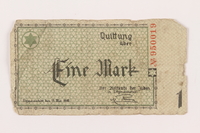
Łódź (Litzmannstadt) ghetto scrip, 1 mark note
Object
1 (eine) mark receipt issued in the Łódź ghetto in German occupied Poland beginning in May 1940 until the ghetto was liquidated in summer 1944. Nazi Germany invaded Poland on September 1, 1939, and occupied Łódź one week later. Łódź was renamed Litzmannstadt and, by February 1940, the Germans forcibly relocated the large Jewish population of 160,000 into a small, sealed ghetto. All residents had to do forced labor, many in ghetto factories. Residents were forbidden to have German currency, and the Jewish Council was ordered to create a system of Quittungen [receipts] for use only in the ghetto. The scrip, referred to as rumkis after the Elder of the Judenrat, Mordechai Rumkowski, was issued in 7 denominations: 50 pfenning, 1, 2, 5, 10, 20, 50, and 100 marks, as well as coins. It was a labor incentive and facilitated the confiscation of money and goods from internees. There was little to exchange it for in the ghetto. Living conditions were horrendous; the severe overcrowding and lack of food made disease and starvation common. In January 1942, mass deportations to Chelmno killing center began; half the residents were murdered by the end of the year. In summer 1944, Łódź, the last ghetto in Poland, was destroyed and the remaining Jews were sent to Chelmno and Auschwitz-Birkenau killing centers.



